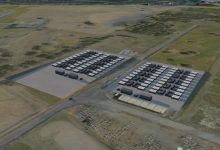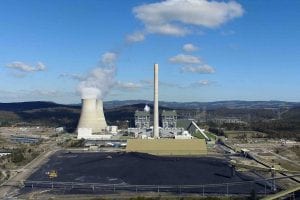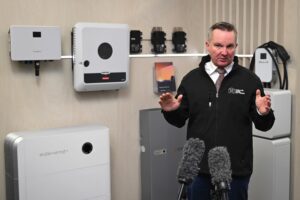One of Australia’s oldest and most polluting power stations – the Yallourn brown coal generator in Victoria – is to close four years early and will be partially replaced by what is being described as the world’s biggest battery.
EnergyAustralia’s Jeeralang big battery – sized at 350MW and 1400MWh – may be the biggest battery “commitment” made to date, but even bigger batteries have already been mooted in Australia and overseas, and will likely be built by the time Jeeralang is delivered at the end of 2026.
But what is clear is that there is a massive shift happening here. Coal is on the way out, as is “baseload” gas, and wind and solar and storage facilities, particularly battery storage, are on the way in. And many of the biggest batteries are being planned at the sites of coal and gas generators already closed or expected to close in coming years or decades.
EnergyAustralia is not the first to announce that its flagship fossil fuel generator will be at least partially replaced by a big battery.
AGL has already announced it is building big battery storage at the site of three of its biggest coal and gas generators – at the Liddell coal plant in NSW (due to close 2023), at the Torrens gas generator in South Australia (to partially close in 2023), and the Loy Yang A coal plant in Victoria (due to close in 2048, but likely well before then).
The sizes it is mooting are up to 500MW (and maybe two hours storage) for Liddell, 250MW and four hours storage at Torrens (1,000MWh), and 200MW and four hours storage (800MWh) at Loy Yang A. The final call on storage duration will be determined by the sort of market opportunities it sees for the batteries in the different states – longer for storing excess wind and solar, shorter for grid security services.
Origin has already announced plans for a big battery of up to 700MW and four hours storage (2,800MWh) at its Eraring coal generator in NSW, currently scheduled to close by 2032, but which analysts think may close earlier. It is also considering big batteries adjoining its Mortlake, Uranquinty and Darling Downs gas generators.
French energy giant Neoen recently submitted planning documents for a 500MW/1,000MWh big battery to be constructed at the site of the former Wallerawang coal power station, west of Sydney, adding to the range of big battery projects it has already built, or is building, in Victoria, South Australia and NSW.
And in South Australia, Sanjeev Gupta’s GFG Alliance is about to start construction of the Playford big battery – finances willing – at the site of the sub-station that supplied the now closed Northern and Playford coal generators near Port Augusta. One smaller battery has already been built there next to the Lincoln Gap wind farm.
Of course, numerous other batteries are being built elsewhere in the network – next to wind and solar farms in some cases, and at key network junctions in others. Smaller batteries are also being built across distributed networks. See: Ausgrid installs “first of many” community batteries on Sydney network
But the siting of big battery storage next to coal and gas assets is not just about convenience, and plugging in to the existing network infrastructure. It’s also a sign of the scale and the speed of the energy transition.
“The energy market transition is real and it’s happening fast,” EnergyAustralia’s Catherine Tanna told journalists on Wednesday. “I think it’s fair to say it’s happening faster than most people forecast.”
That’s a familiar theme, now being recognised by all of Australia’s big energy incumbents, with the possible exception of the federal government owned Snowy Hydro, which for obvious reasons is attached to big pumped hydro, like Snowy 2.0.
AGL, for instance, now talks of the “dawn of the battery age”, and is expected to unveil a significant change in strategy as it absorbs the scale of the transition and how its business model can adapt.
Battery storage will provide many, if not all, of the grid services now offered by coal and gas generators, but they will not, of course, replace the output of the big coal and gas generators.
More wind and solar plants will be needed to provide the generation capacity, and now that green hydrogen is being embraced it seems likely that enough capacity will be built to comfortably meet Australia’s electricity needs.
The challenge, over the short term, is to ensure that this is built in time, along with the network infrastructure. That’s not just a challenge for the battery storage industry, it’s also a challenge for the market rule makers and regulators to ensure the right signals and market structures are in place, in plenty of time.
As the Australian Energy Market Operator noted after the Yallourn announcement:
- The 2020 Integrated System Plan flagged that 63 per cent of today’s coal-fired power stations would retire by 2040, replaced by wind and solar projects, which would be complemented by firming generation, such as battery storage, pumped hydro and gas.
- As the energy transition continues to gain pace, it is increasingly important that the ESB market reforms are progressed to ensure the exit of thermal plants is coordinated with the timely entry into the market of new dispatchable capacity to keep consumer prices low and energy reliable.
It also means that the politicians have to catch up, particularly those in the federal Coalition trying to convince themselves that either new coal generators or a “gas-led recovery” is the answer.
Right now, it’s the state governments that are leading on the transition, but as long as there is no leadership and daft comments at national level, then the state-based efforts will be piecemeal. It’s time to embrace the clean energy transition.








